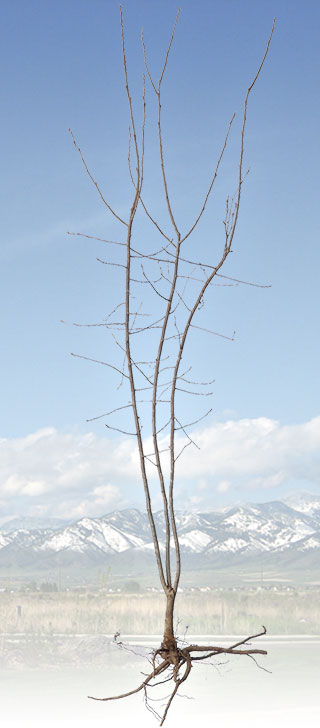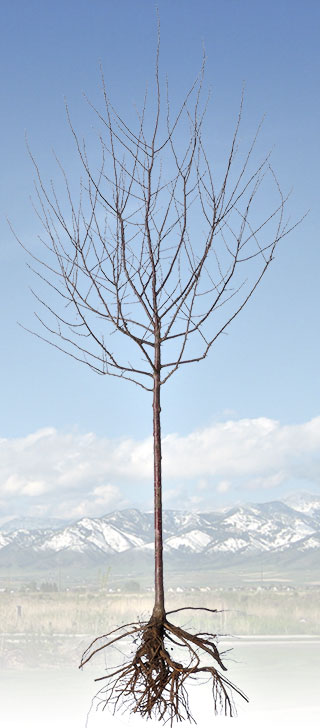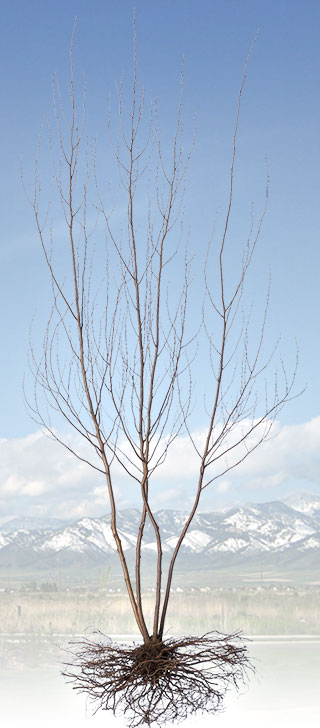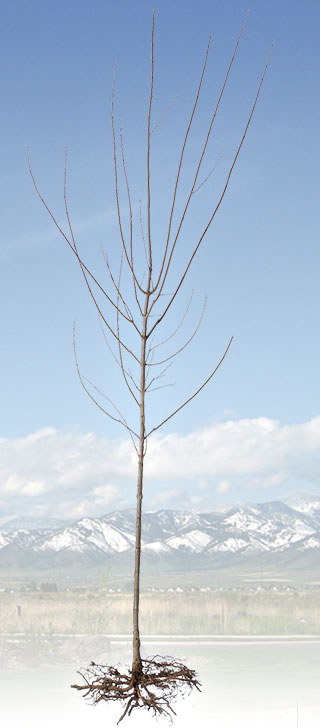 Ever wonder how the trees and shrubs you purchase at the garden center were grown? If they are in a pot, was the seed planted directly into that pot? Or was the plant moved into the pot at some point or dug from the ground and placed in the pot? Trees and shrubs can be purchased in different forms—with a root ball, in containers, or bare root.
Ever wonder how the trees and shrubs you purchase at the garden center were grown? If they are in a pot, was the seed planted directly into that pot? Or was the plant moved into the pot at some point or dug from the ground and placed in the pot? Trees and shrubs can be purchased in different forms—with a root ball, in containers, or bare root.
The ball and burlap method of digging trees, often abbreviated B&B, is most often used for trees whose trunk diameter is over 2”. The larger the tree, the more difficult it is to transplant; the B&B method does not expose the roots to the air and keeps the root system intact. Evergreens are often balled and burlapped; their roots should not be exposed when transplanting because evergreens do not go into full dormancy like deciduous trees who drop their leaves do.
 During the dormant season, trees to be balled and burlapped are dug by hand or with a tree spade and the root ball is placed in a cone-shaped wire basket lined with burlap. The burlap is secured at the top and tied with twine around the trunk of the tree. When planting balled and burlapped trees, we recommend leaving the wire basket on the root ball to keep it from falling apart. Keep the top of the root ball at ground level. Don’t dig your hole too deep—the heavy ball might sink in the loose soil. Remove any twine from around the trunk and pull back or cut off the burlap from the top of the root ball.
During the dormant season, trees to be balled and burlapped are dug by hand or with a tree spade and the root ball is placed in a cone-shaped wire basket lined with burlap. The burlap is secured at the top and tied with twine around the trunk of the tree. When planting balled and burlapped trees, we recommend leaving the wire basket on the root ball to keep it from falling apart. Keep the top of the root ball at ground level. Don’t dig your hole too deep—the heavy ball might sink in the loose soil. Remove any twine from around the trunk and pull back or cut off the burlap from the top of the root ball.
 A relatively new method of raising large trees is called “pot-in-a-pot”. Big plastic pots are sunk into the ground; another pot fits snugly inside where the tree is planted. The soil around the pots insulates the roots in the winter and cools them in the summer. Trees growing in these pots can be lifted and sold at any time of the year, not just when the tree is dormant, because no roots have to be cut. The inside pot is simply lifted out.
A relatively new method of raising large trees is called “pot-in-a-pot”. Big plastic pots are sunk into the ground; another pot fits snugly inside where the tree is planted. The soil around the pots insulates the roots in the winter and cools them in the summer. Trees growing in these pots can be lifted and sold at any time of the year, not just when the tree is dormant, because no roots have to be cut. The inside pot is simply lifted out.
Many nurseries grow junipers, dwarf evergreens, roses, and shrubs in containers, starting from a small seedling or cutting. Because the pots sit above ground, this method works well in the cool, damp, ideal growing climates of the west coasts of Oregon and Washington. In harsher, colder climates, pots must be protected by mulch or covered in the winter so the roots of the plants in containers are not damaged. Container grown plants are easy to plant; they slide right out of the pot. Transplant shock is less because no roots are cut, although they can become root-bound if grown in the pot too long. Break up or loosen roots that are bound or circling before you plant them. Containerized plants grown in a light soil mix can dry out quickly after transplanting, especially in the heat and low humidity of our summers. Check soil moisture level daily until the plants are established in their new site.
 Many of the deciduous trees and shrubs you purchase at garden centers have been dug out of the growers’ rows bare root in the fall after they go dormant, stored in refrigerated buildings all winter where they are sorted, graded, and bundled, and then shipped to garden centers in the spring. Because there is no dirt on the roots, bare root plants are light and easy to handle but the roots must be kept cool, but not freezing, and never allowed to dry out.
Many of the deciduous trees and shrubs you purchase at garden centers have been dug out of the growers’ rows bare root in the fall after they go dormant, stored in refrigerated buildings all winter where they are sorted, graded, and bundled, and then shipped to garden centers in the spring. Because there is no dirt on the roots, bare root plants are light and easy to handle but the roots must be kept cool, but not freezing, and never allowed to dry out.
Most garden centers sell strawberry, raspberry, and hedge plants bare root. Some nurseries have large spaces of refrigerated, humidified storage space that allows them to hold quantities of bare root deciduous trees and shrubs dormant until they are purchased by the customer in the spring or planted into pots for later sale. Because it easier to raise, dig, and transport large quantities of bare root plants, they are less expensive than balled and burlapped or container grown. Bare root plants are light and can be bundled for easy transport, even in the trunk of a car. The roots of bare root plants should be wrapped with damp material so they don’t dry out when transporting. It is important that these bare root plants be planted soon after leaving the cool, humid storage. Letting the roots dry out could harm the plants.
Most garden centers sell strawberry, raspberry, and hedge plants bare root. Some nurseries have large spaces of refrigerated, humidified storage space that allows them to hold quantities of bare root deciduous trees and shrubs dormant until they are purchased by the customer in the spring or planted into pots for later sale. Because it easier to raise, dig, and transport large quantities of bare root plants, they are less expensive than balled and burlapped or container grown. Bare root plants are light and can be bundled for easy transport, even in the trunk of a car. The roots of bare root plants should be wrapped with damp material so they don’t dry out when transporting. It is important that these bare root plants be planted soon after leaving the cool, humid storage. Letting the roots dry out could harm the plants.
Because bare root plants need to start growing, the bare root planting season ends at the beginning of June. During the summer months, potted plants can be purchased. Care should be taken when planting potted trees and shrubs to keep dirt on the roots and not expose root hairs to the air. Cut the pots and peal them off once the plant has been placed in its hole.
Potted, bare root, container grown, or balled and burlapped plants—you can have success planting any of these if you use the correct planting methods.
